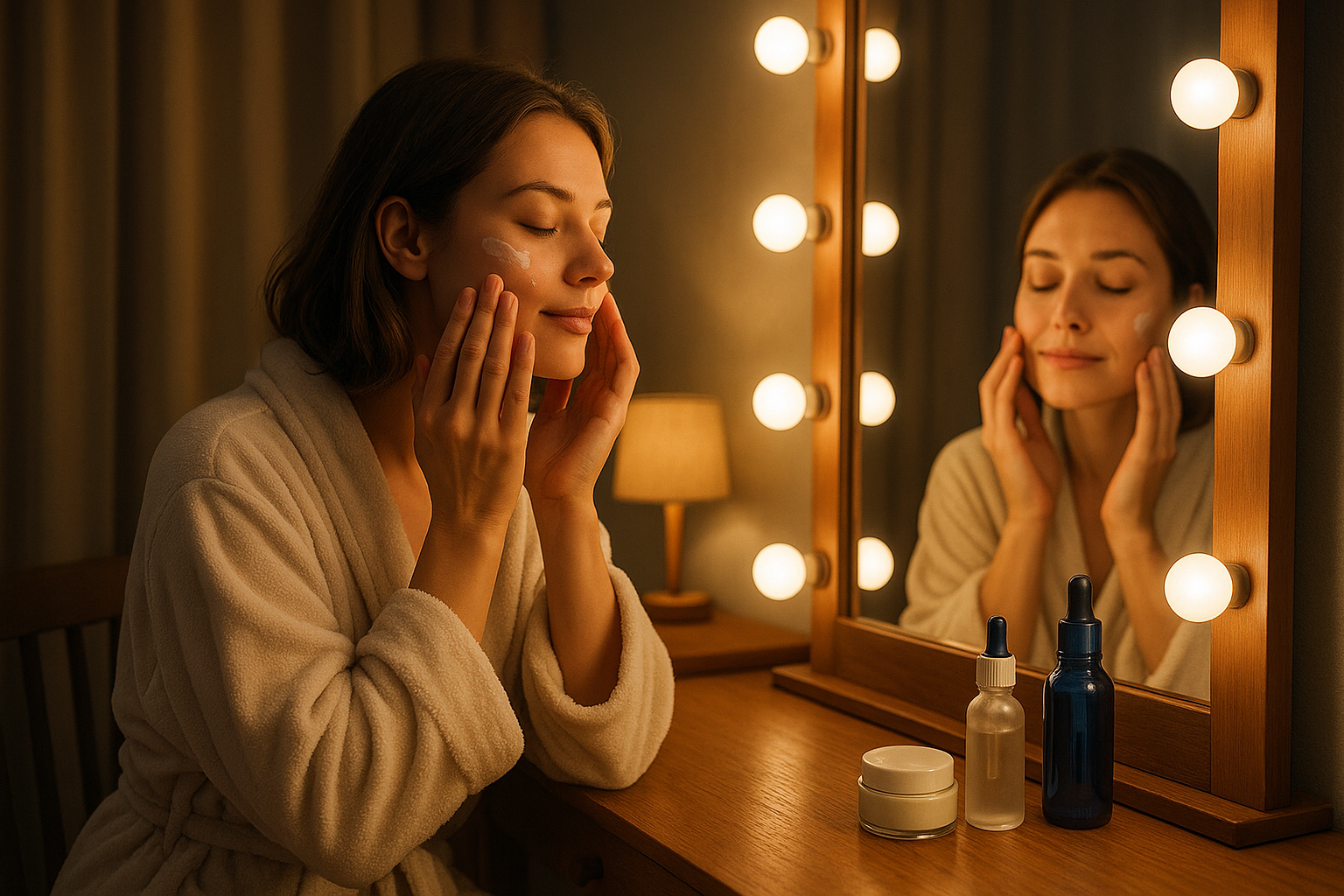The way you treat your skin at night has a significant impact on how it looks in the morning. While you sleep, your body enters a restorative state — and your skin, the largest organ, works hard to regenerate, repair, and recover from the day’s stressors like pollution, UV exposure, and makeup.
A well-planned nighttime skincare routine doesn’t just cleanse your skin; it maximizes this natural regeneration process, ensuring you wake up with a refreshed, radiant, and healthy-looking complexion.
In this guide, we’ll cover the science behind nighttime skincare and walk you through a step-by-step routine to wake up glowing.
Why Nighttime Skincare Matters
At night, your skin is:
- More permeable, making it more receptive to active ingredients.
- Not exposed to sunlight or pollution, reducing stressors.
- Undergoing repair, including collagen synthesis and cellular renewal.
This makes bedtime the best opportunity to treat concerns like dryness, fine lines, dullness, or acne — without competing with external aggressors.
Step-by-Step Nighttime Routine for Radiant Skin
Here’s how to build a powerful nighttime skincare ritual that supports repair and nourishment:
Step 1: Remove Makeup Thoroughly
Sleeping with makeup on is a recipe for clogged pores, breakouts, and dull skin.
Best Options:
- Micellar water for light makeup
- Cleansing balms or oils for heavy makeup or SPF
Gently massage the remover over your face, then wipe or rinse to ensure a clean slate.
Step 2: Cleanse Your Skin
Double cleansing is a game-changer at night. The first step removes makeup and surface impurities; the second step removes deep-seated dirt, sweat, and pollution.
Choose a cleanser based on your skin type:
- Dry skin: Cream or milk cleanser
- Oily skin: Gel or foam cleanser with salicylic acid
- Sensitive skin: Gentle, fragrance-free cleanser
Massage gently for 30–60 seconds and rinse with lukewarm water.
Step 3: Apply a Toner or Essence (Optional)
This step helps balance your skin’s pH and preps it for deeper penetration of serums and moisturizers.
Look for:
- Hydrating toners with rose water, glycerin, or aloe
- Exfoliating toners (use 2–3x/week) with glycolic or lactic acid
Pat into the skin using your hands or a cotton pad.
Step 4: Use a Treatment Serum
This is the step where you personalize your routine based on your skincare goals.
Popular nighttime serums:
- Retinol or Retinoids: Stimulate collagen and reduce fine lines
- Niacinamide: Improves texture and brightens
- Hyaluronic acid: Deep hydration
- Bakuchiol: A gentler retinol alternative for sensitive skin
Apply a few drops and press into the skin — don’t rub aggressively.
Step 5: Lock in Moisture with Night Cream
Moisturizers seal in your serums and provide long-lasting hydration.
Choose based on your needs:
- Rich creams with shea butter or ceramides for dry skin
- Gel-based moisturizers for oily or acne-prone skin
- Barrier-repair creams for sensitive or irritated skin
If you sleep in an air-conditioned or dry room, consider applying a sleeping mask for extra hydration.
Step 6: Target the Eye Area
The skin around the eyes is thinner and more delicate. Use an eye cream or gel with:
- Caffeine (for puffiness)
- Peptides (to smooth lines)
- Hyaluronic acid (for plumping)
Tap gently with your ring finger — never pull or stretch the skin.
Step 7: Lip and Neck Care
Don’t forget your lips and neck!
- Use a hydrating lip balm before bed.
- Apply your regular night cream or a dedicated neck cream on the neck and décolleté in upward motions.
Bonus Tips for Enhancing Your Nighttime Routine
🧼 Keep Your Pillowcases Clean
Change them at least twice a week to avoid bacteria and oil buildup.
💤 Sleep on Your Back
It reduces friction and prevents lines on your face.
🌬️ Use a Humidifier
This keeps the air moist, helping your skin retain hydration.
🍵 Avoid Late Caffeine or Heavy Meals
They can interfere with quality sleep, which impacts skin regeneration.
Example Night Routine for Different Skin Types
| Skin Type | Suggested Night Routine |
|---|---|
| Dry Skin | Oil cleanser → Cream cleanser → Hydrating toner → Hyaluronic acid serum → Rich moisturizer → Lip balm |
| Oily Skin | Gel cleanser → Toner with salicylic acid → Niacinamide serum → Gel moisturizer |
| Aging Skin | Cleansing balm → Cream cleanser → Retinol serum → Peptide-rich night cream |
| Sensitive Skin | Micellar water → Gentle cleanser → Soothing toner → Bakuchiol serum → Barrier cream |
Common Nighttime Skincare Mistakes to Avoid
❌ Using Harsh Exfoliants Daily
Over-exfoliating at night can damage the skin barrier. Stick to 1–3 times a week.
❌ Skipping Moisturizer
Even oily skin needs hydration. Without it, your skin may overproduce oil.
❌ Applying Products in the Wrong Order
Always go from thinnest (serum) to thickest (moisturizer) for proper absorption.
❌ Sleeping Without Cleansing
This allows buildup of bacteria and pollutants — the opposite of healing.
Why You Might Wake Up with Dull Skin
Even with a full routine, if you’re waking up with tired or dull skin, consider:
- Poor sleep quality or not enough rest
- Dehydration or alcohol before bed
- Using the wrong skincare ingredients for your skin type
- Sleeping in a dry environment without a humidifier
Conclusion: Glow Starts Before You Sleep
Waking up with glowing, hydrated skin doesn’t happen by accident — it’s the result of consistency, smart ingredient choices, and honoring your skin’s natural rhythms.
By building a nighttime skincare routine that nourishes and restores, you set the stage for a healthier, brighter complexion every morning. It’s not about perfection — it’s about progress, and treating your skin with the care it deserves.
🌙 Sleep is skincare — let your routine work while you rest.
